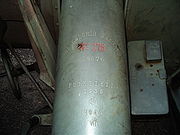
Obukhov State Plant
Encyclopedia

Russia
Russia or , officially known as both Russia and the Russian Federation , is a country in northern Eurasia. It is a federal semi-presidential republic, comprising 83 federal subjects...
n metallurgy and heavy machine-building plant
Factory
A factory or manufacturing plant is an industrial building where laborers manufacture goods or supervise machines processing one product into another. Most modern factories have large warehouses or warehouse-like facilities that contain heavy equipment used for assembly line production...
in St. Petersburg, Russia
Russia
Russia or , officially known as both Russia and the Russian Federation , is a country in northern Eurasia. It is a federal semi-presidential republic, comprising 83 federal subjects...
. It was founded in 1863 to produce naval artillery
Naval artillery
Naval artillery, or naval riflery, is artillery mounted on a warship for use in naval warfare. Naval artillery has historically been used to engage either other ships, or targets on land; in the latter role it is currently termed naval gunfire fire support...
based on German designs by Krupp
Krupp
The Krupp family , a prominent 400-year-old German dynasty from Essen, have become famous for their steel production and for their manufacture of ammunition and armaments. The family business, known as Friedrich Krupp AG Hoesch-Krupp, was the largest company in Europe at the beginning of the 20th...
. It has since been a major producer of artillery and other military equipment. From 1922 to 1992 it was renamed Bolshevik Plant no. 232.
In the late 1920s, it became one of the two main Soviet tank factories (along with the Kharkov Locomotive Factory), and produced the first indigenous tank, the T-18
T-18 tank
The T-18 light tank was the first Soviet-designed tank. Produced from 1928–31, it was based on the Renault FT-17, with the addition of a vertically sprung suspension....
. It later became home to the OKMO
OKMO
OKMO was the main tank design team in the Soviet Union during the early 1930s. It produced the design of the T-26 infantry tank , of which about 12,000 would be produced...
tank design bureau, which was responsible for the T-26 infantry tank, of which over 12,000 were built.
In 1935, after the assassination of Sergey Kirov
Sergey Kirov
Sergei Mironovich Kirov , born Sergei Mironovich Kostrikov, was a prominent early Bolshevik leader in the Soviet Union. Kirov rose through the Communist Party ranks to become head of the Party organization in Leningrad...
, the factory was officially renamed Factory No. 185 (S.M. Kirov), although Leningrad inhabitants continued to refer to it as the Bolshevik Factory (Zaloga 1984:53).
Shortly after the German invasion
Operation Barbarossa
Operation Barbarossa was the code name for Germany's invasion of the Soviet Union during World War II that began on 22 June 1941. Over 4.5 million troops of the Axis powers invaded the USSR along a front., the largest invasion in the history of warfare...
, Tank Factory No. 185 was evacuated from Leningrad to Chelyabinsk
Chelyabinsk
Chelyabinsk is a city and the administrative center of Chelyabinsk Oblast, Russia, located in the northwestern side of the oblast, south of Yekaterinburg, just to the east of the Ural Mountains, on the Miass River. Population: -History:...
in the Urals in July 1941. It moved again to Omsk
Omsk
-History:The wooden fort of Omsk was erected in 1716 to protect the expanding Russian frontier along the Ishim and the Irtysh rivers against the Kyrgyz nomads of the Steppes...
in 1961.
The Leningrad factory's historical name was restored in 1992 by the formation of a unitary enterprise, FSUE Obukhov State Plant. In 2002 it became part of the Almaz-Antey
Almaz-Antey
OJSC "Concern PVO "Almaz-Antey" is a Russian joint undertaking in the arms industry, a result of a merger of Antey Corporation and NPO Almaz, unifying some of the national military enterprises, in particular, the developers of anti-aircraft defence systems . The organisation is headquartered in...
military industrial concern, and in 2003, it became a joint-stock company, OJSC GOZ Obukhov Plant.

